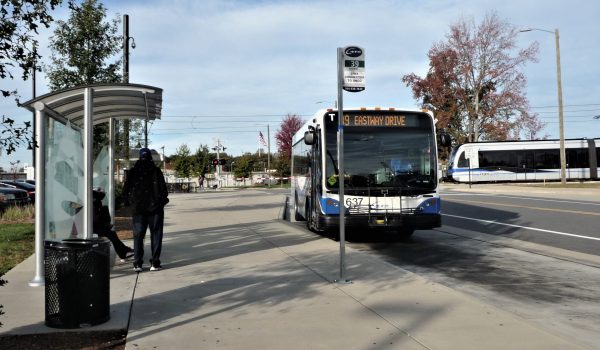10-minute neighborhoods, what are they and what do they consist of?

Charlotte has made plans to introduce 10-minute neighborhoods throughout the city. But what are they and what do they consist of? Read through John Kinsey’s (Current MA in Geography Graduate Student) blog post detailing the latest urban planning tool used to foster more mobility options.
Chrono-urbanism: Time for Pedestrianized Cities
By: John Kinsey, MA in Geography Student
Supervisors: Dr. Michelle Zuñiga and Dr. Katherine Idziorek
May 11, 2023
Throughout the spring 2023 semester, I took on an independent study with Professors
Michelle Zuñiga and Katherine Idziorek to study urban sustainability through chrono-urbanism.
Popularized at the height of the Covid 19 pandemic by urbanist Carlos Moreno and the Mayor of
Paris, Anne Hidalgo, chrono-urbanism is an urban planning strategy making important services
and amenities accessible within travel minutes (normally 10-, 15-, or 20-minute increments) for
residents through an alternative means to a car such as walking, cycling, or public transit (Duany
and Steutville, 2021). Accordingly, chrono-urbanism has been a growing initiative taking off in
several cities across the globe, providing more pedestrian-friendly urban spaces by rebuilding
cities around restaurants, shops, and amenities where the usage of a car is not necessary. While
this strategy sounds promising for urban sustainability, several questions remain. How do cities
implement chrono-urbanist policies? What are its typical attributes? How do cities develop and
achieve their chrono-urbanist goals?
To further unpack these questions, I found that eight of the top 75 cities (those considered
the largest by population) in the United States (New York City, Charlotte, Denver, Boston,
Portland, Detroit, Minneapolis, Cleveland) have adopted chrono-urbanist plans. New York City,
New York aspires to transform five neighborhood blocks in Astoria, Queens in order to bring
about sustainable and equitable infrastructure where walkability and pedestrianization are crucial
(Elevator World, 2023). Additionally, Seattle, which has not officially adopted any plans, does
indeed have ideas for chrono-urbanism which may appear in the city’s official comprehensive
plan to be updated in 2024 (Argerious, 2020). Detroit, Michigan is in the process of creating a
20-minute neighborhood policy, connecting communities to the city’s greenway system (Detroit
Greenway Coalition, 2023). The theme of mixed-use development, and planning so that
everything is in close proximity and not separated through single-use zoning are commonly
recognized in chrono-urbanism policies.
In Charlotte, North Carolina, the idea of a more ambitious 10-minute neighborhood can
be found as the first policy goal listed in the City’s recently adopted Future 2040 Comprehensive
Plan. In the section of the plan describing the city’s goals, the City of Charlotte has listed
aspirations that reflect the Congress of New Urbanism’s (CNU) ideals of chrono-urbanism, such
as ensuring tree-shaded, walkable, car-free areas where services and amenities like grocery
stores, restaurants, cafés, parks, and storefronts are all within a 10-minute distance from
residents’ homes (City of Charlotte, 2023).
Throughout the course of the semester, Professors Zuñiga and Idziorek as Gambrell
Fellows with the Urban Institute, also carried out interviews with residents to learn more about
what amenities and services are important to them in a 10-minute neighborhood. Specifically,
they interviewed residents in two of Charlotte’s Corridors of Opportunity (the I-85/Sugar Creek
Corridor and the Central/Albemarle Corridor) to get a sense of how different modes of
transportation factor into residents’ daily lives, their experiences commuting, and what they think
of Charlotte’s goal of 10-minute neighborhoods. Many of the residents were supportive of the
policy, but claimed a 10-minute neighborhood was a far reach given their experiences with the
transportation network, namely, Charlotte’s unreliable bus system. In particular, residents noted
infrequent arrival times and inconvenient schedules, which caused many interviewees to prefer
using their own personal automobile rather than the bus. In order to make a 10-minute
neighborhood possible, many respondents said they would like to see more frequent buses, more
bus stops, enhanced safety on public transportation, and streets with complete sidewalk
connectivity.
In terms of climate change and sustainability, a reduction of car-oriented spaces not only
reduces greenhouse gas emissions from motor vehicles, but also ensures cleaner alternatives such
as walking, cycling, or taking some form of public transportation are promoted. A variety of
commuting types (i.e., biking and walking) with emphasis put on social and environmental
benefits such as reductions in greenhouse gas emissions, preservation of tree canopies, and
denser land usage, are encouraged in chrono-urbanism. Chrono-urbanist policies also aim to
promote equity by ensuring all users have a way to reach their destinations regardless of what
mode of transportation they use. Car-oriented development, on the other hand, leaves many
people who are unable to drive or who cannot afford to buy or maintain a vehicle without
options, resulting in unequal opportunities in regards to reaching jobs, shopping, children’s
schools, or other places they need to go. With increased conversations about chrono-urbanism
across the U.S., cities should focus their attention on using these policies to address goals
regarding climate change and equity, including heeding residents’ calls for improved public
transit in Charlotte.
Sources:
Argerious N. (2020). Seattle’s Quest to Become a 15-Minute City. The Urbanist. Retrieved from:
https://www.theurbanist.org/2020/09/18/seattles-quest-to-become-a-15-minute-city/
City of Charlotte. (2023). Plan Policy. Retrieved from:
https://www.cltfuture2040plan.com/content/goal-1-10-minute-neighborhoods-0
Detroit Greenways Coalition. (2023). “Twenty Minute Neighborhoods. Retrieved from:
https://detroitgreenways.org/twenty-minute-neighborhoods/
Duany A. & Steuteville R. (2021). Defining the 15-Minute city. Congress of New Urbanism.
Retrieved from: https://www.cnu.org/publicsquare/2021/02/08/defining-15-minute-city
Elevator World. (2022). 15-Minute City” Master Plan Approved in NYC Borough. Retrieved
from: https://elevatorworld.com/news/daily-news/15-minute-city-master-plan-approved-in-nyc-
borough/